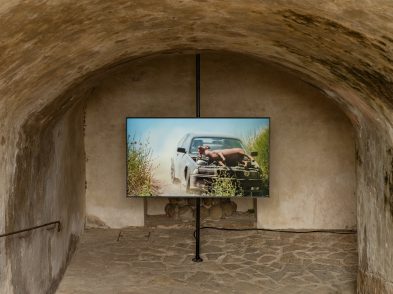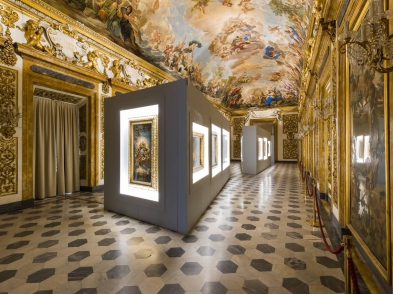Arabella Natalini has been one of the leading figures in contemporary
art in Tuscany for more than 10 years. Part of the team that bid successfully
to transform the vacant auditorium on viale Giannotti into the exhibition venue
EX3, Natalini started 2012 with her appointment as the centre’s co-artistic
director. The first exhibition under this new leadership has just opened. In Do
You Believe in Mirages? artist Jacopo Miliani, winner of
the second Premio EX3 Toscana competition, has converted the immense central
hall into a fictional desert. Dusty with sand under harsh lights, the room
resembles an arena before a performance. As amplifiers filter in rock music and
words appear where palm trees should be, Miliani’s vacant space awaits
animation by visitors’ thoughts and fantasies. In a sense, his installation
imaginatively captures the essence of EX3 itself. As TF’s conversation with her
suggests, Natalini wants people to think more deeply about the spaces around
them.
Tell me about your background.
You were born in London.
My mother was English and wanted me born in England, where fathers could
be present in the delivery room, unlike in Italy in those days. I was in London
for only two months. I was raised in the countryside just outside Florence,
although for a year the family lived in Rhode Island, when my father, an
architect, taught at the Rhode Island School of Design.
Your father, Adolfo, is
associated with the conceptual architecture of the 1970s. Did his approach
influence your way of thinking about art?
Yes and no. As a young child, I was involved in the performances and
films that my parents’ friends and colleagues made, and I thought it was fun.
Later on, as a family we often visited museums, biennale exhibitions and old
churches-many old churches-but like any teenager, I yearned for the
conventional lifestyle of my Florentine friends. Then, when I was 16 or 17, I
became increasingly interested in contemporary culture. It was the mid-1980s,
and even the nightclubs we visited had parties themed around radical
architecture! To my surprise, one club displayed photographs from those
performances of my childhood and I found myself talking to my friends about the
ideas that inspired my father’s generation.
How did you become involved in
the art world? Through art history?
I attended the University of Florence and eventually persuaded the
faculty to allow me to study contemporary art. By then, what interested me was
the social context in which different art forms come together to make a
culture. The university, however, pursued more traditional lines and insisted
on students learning names, styles and dates. Fortunately, I was assigned an
inspirational tutor, art historian Ester Coen, who understood my desire to
participate in the ongoing history of art that embraces the present. My
research was considered experimental and led me quite naturally into a career
with artists to make exhibitions and site-specific projects.
Was there an artwork that
particularly impressed you early in your career?
There were many, but one I won’t forget was created by Massimo Bartolini
in Florence. In a sense, it was made of nothing but it deeply enriched my
perception of an existing space. His intervention was extremely simple: he
traced the architecture of a room by drawing lines in marker pen where the
planes of walls, ceiling, buttresses and window recesses converged. He set up a
strong interaction with what was already there and, in the process, the room
became something else; it seemed to enter a different dimension.
You worked in Siena on projects
that integrated art with public space.
I was a curator at Siena’s Palazzo delle Papesse and then, in 2002,
became art director of the contemporary art association in Chianti,
Tusciaelecta. We collaborated with more than 50 international artists and the
residents of towns and rural communities between Florence and Siena. These were
ambitious initiatives with small staffs and small budgets: temporary artworks
by leading Italian and international figures and permanent additions to public
buildings, by Mario Merz at San Casciano, for instance, and Flavio Favelli in
Florence. Everyone took on numerous tasks, from negotiating with politicians to
meeting local inhabitants. It really became my life: I was totally absorbed.
Did long-established communities
welcome the arrival of new art in familiar locations?
These installations did raise questions. The Renaissance and the Middle
Ages are strong presences in these areas. Local people were often unhappy at
first, but with information and a few conversations about our plans, their
point of view began to change. It is important that residents become part of a
process that invites people to reconsider spaces they know so well that they
hardly notice them anymore. I am convinced that art has a good effect in
bringing about small but vital shifts in our perceptions.
EX3 opened in October 2009. Who
is it for and what is its mission?
It exists for the people living in Florence and for Italian artists.
There are still few places like this in Italy, and for a long time, Florentine
artists were penalised by the popular image that there was no contemporary art
in the city. So younger artists would move away: for example, Jacopo Miliani is
from Florence and moved to Milan to work. So we introduce neighbours to one
another, to Italian and foreign artists building international reputations. Not
just young ones but also those in mid-career, like Eva Marisaldi and Marzia
Migliora. Our objective is to present varied points of view and to constantly
pose questions.
You have just become co-artistic
director with Lorenzo Giusti. Are two heads better than one?
Lorenzo and I have been working together for several years, at EX3 and
Tusciaelecta. We have different backgrounds, know different artists and have
different interests, which means we can cover a wider field. Discussion and
collaboration are strong features of EX3: with artists, visitors, communities
and sponsors. That approach extends to how we implement our programme.
EX3 occupies a functional
building on the edge of the city. Is this location a disadvantage?
Because we are not in the centre, our visitors must seek us out. They
come because they want to. Over 60,000 have visited since we opened, so I think
the perception of being distant is changing, especially among the younger
population. We have free admission and guided tours, evening concerts and a
bar. And although the building is new, the area is full of history. The
Longinotti factory once stood here, and for 12 years the site was an important
social centre. Now we share the piazza with the Coop and other big stores, at
the heart of the centro commerciale rather than the centro storico.
EX3 has no permanent collection.
Does Florence need to establish a collection of modern art to set beside the
historical collections for which the city is famous?
It would be good. At present, there is an important contemporary
collection at the Luigi Pecci Centre for Contemporary Art in Prato. The
priority in Florence is to have spaces where new art can be experienced, like
BASE, the Strozzina, Marino Marini Museum, and now EX3.
In its programme, has EX3
neglected some areas of contemporary activity, such as painting, in order to
concentrate on photography, film and installation?
We do not prefer one medium to another; we reflect the wide range of
practices among today’s artists. The physical shape of the space, however,
creates opportunities that especially suit installation and are less convenient
for painting. Last year, however, we had a very successful exhibition by the
Scottish artist Charles Avery that included his drawings, as well as objects.
Finally, how do you describe the
modern role of curator?
As a hybrid job. Of course, a curator knows the art scene, meets artists
and develops ideas for shows. But now that person needs many skills in addition
to loving art. As well as demonstrating the visual skill of installing an
exhibition well and working with artists, the job requires one to deal with
practical aspects of managing people and a building, liaising with the public
and the interests of visitors, and maintaining budgets. These skills, although
seemingly invisible, are essential to the success of projects.






